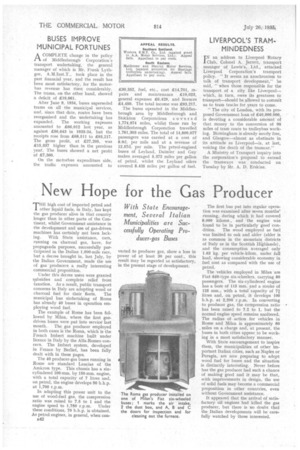New Hope for the Gas Producer
Page 60

If you've noticed an error in this article please click here to report it so we can fix it.
THE high cost of imported petrol and other liquid fuels, in Italy, has kept the gas producer alive in that country longer than in other parts of the Continent, whilst Government assistance in the development and use of gas-driven machines has certainly not been lacking. With State assistance, cars, running on charcoal gas, have, for propaganda purposes, successfully participated in the Italian 1,000-mile race, but a decree brought in, last July, by the Italian Government, made the use of gas ' producers a really interesting commercial proposition.
Under this decree users were granted subsidies and complete relief from' taxation. As a result, public transport concerns in Italy are adopting wood or charcoal fuel for their fleets. The municipal bus uhdertaking of Rome has already 40 buses in operation employing wood fuel.
The example of Rome has been fol-, lowed by Milan, where the first gasdriven buses were put into service last month. The gas producer employed in both cases is the Roma, which is the French Imbert machine built under licence in Italy by the Alfa-Romeo concern. The Imbert system, developed in France by Berliet, has been fully dealt with in these pages.
The 40 producer-gas buses running in Rome are standard Lancias of the Amicron type. This chassis has a sixcylindered 100-mm. by 150-mm. engine, with a total capacity of 7 litres and, on petrol, the engine develops 90 b.h.p. at 1,700 r.p.m.
In adapting this power unit to the use of wood-fuel gas, the compression ratio was raised to 7.5 to 1 and the engine speed to 1,750 r.p.m. Under these conditions, 70 la.h.p. is obtained. As petrol engines, in general, when con
verted to producer gas, show a loss in power of at least 30 per cent., this result may be regarded as satisfactory, in the present stage of development.
The first bus put into regular operation was examined after seven months' running, during which it had covered 8,000 kiloms., and the engine was found to be in particularly good condition. The wood employed as fuel was limited to oak and alder (alder is as common in the mountain districts of Italy as in the Scottish Highlands), and the consumption averaged only 1.63 kg. per vehicle-kilom. under full load, showing considerable economy in fuel cost as compared with the use of petrol.
The vehicles employed in Milan 'are Fiat 640-type six-wheelers, carrying 80 passengers. The six-cylindered engine has a bore of 115 mm. and a stroke of 125 mm., with a total capacity of 71. litres and, on petrol, it develops 100 b.h.p. at 2,200 r.p.m. In converting to producer gas, the compression ratio has been raised to 7.2 to 1, but the normal engine speed remains unaltered. The radius of action for vehicles in Rome and Milan is approximately 60 miles on a charge and, at present, the buses in both cities appear to be working in a most satisfactory manner.
With State encouragement to inspire them, the municipalities of other important Italian cities, such as Naples or Perugia, are now preparing to adopt wood fuel for buses and the situation is distinctly interesting. Never before has the gas producer had such a chance of making good and it may be that, with improvements in design, the use of solid fuels may become a commercial proposition in other countries, even without Government assistance.
It appeared that the arrival of satisfactory oil engines had killed the gas producer, but there is no doubt that the Italian developments will be carefully watched by those interested.




































































































